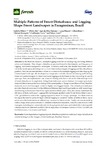Please use this identifier to cite or link to this item:
http://www.alice.cnptia.embrapa.br/alice/handle/doc/1064421| Title: | Multiple patterns of forest disturbance and logging shape forest landscapes in Paragominas, Brazil. |
| Authors: | TRITSCH, I.  SIST, P.   NARVAES, I. da S.   FREITAS, L. J. M. de   BLANC, L.   BOURGOIN, C.   CORNU, G.   GOND, V.   |
| Affiliation: | Isabelle Tritsch, CIRAD; Plinio Sist, CIRAD; Igor da Silva Narvaes, INPE-CRA; LUCAS JOSE MAZZEI DE FREITAS, CPATU; Lilian Blanc, CIRAD; Clément Bourgoin, CIRAD; Guillaume Cornu, CIRAD; Valery Gond, CIRAD. |
| Date Issued: | 2016 |
| Citation: | Forests, v. 7, n. 12, 2016. |
| Description: | In the Brazilian Amazon, multiple logging activities are undergoing, involving different actors and interests. They shape a disturbance gradient bound to the intensity and frequency of logging, and forest management techniques. However, until now, few studies have been carried out at the landscape scale taking into account these multiple types of logging and this disturbance gradient. Here we address this issue of how to account for the multiple logging activities shaping the current forest landscape. We developed an inexpensive and efficient remote sensing methodology based on Landsat imagery to detect and track logging activity based on the monitoring of canopy openings. Then, we implemented a set of remote sensing indicators to follow the different trajectories of forest disturbance through time. Using these indicators, we emphasized five major spatial and temporal disturbance patterns occurring in the municipality of Paragominas (State of Pará, Brazilian Amazon), from well-managed forests to highly over-logged forests. Our disturbance indicators provide observable evidence for the difference between legal and illegal patterns, with some illegal areas having suffered more than three explorations in fifteen years. They also clearly underlined the efficiency of Reduced Impact Logging (RIL) techniques applied under Forest Stewardship Council (FSC) guidelines to reduce the logging impacts in terms of canopy openings. For these reasons, we argue the need to promote legal certified logging to conserve forests, as without them, many actors mine the forest resources without any concerns for future stocks. Finally, our remote tracking methodology, which produces easy to interpret disturbance indicators, could be a real boon to forest managers, including for conservationists working in protected areas and stakeholders dealing with international trade rules such as RBUE (Wood regulation of European Union) or FLEGT (Forest Law for Enforcement, Governance and Trade). |
| Thesagro: | Sensoriamento Remoto |
| NAL Thesaurus: | Amazonia |
| Keywords: | Degradação florestal Impactos de exploração madeireira Padrões de perturbação Indicadores espaciais e temporais Paisagem florestal |
| DOI: | http://dx.doi.org/10.3390/f7120315 |
| Type of Material: | Artigo de periódico |
| Access: | openAccess |
| Appears in Collections: | Artigo em periódico indexado (CPATU)  |
Files in This Item:
| File | Description | Size | Format | |
|---|---|---|---|---|
| MultiplePatterns.pdf | 5,33 MB | Adobe PDF |  View/Open |









